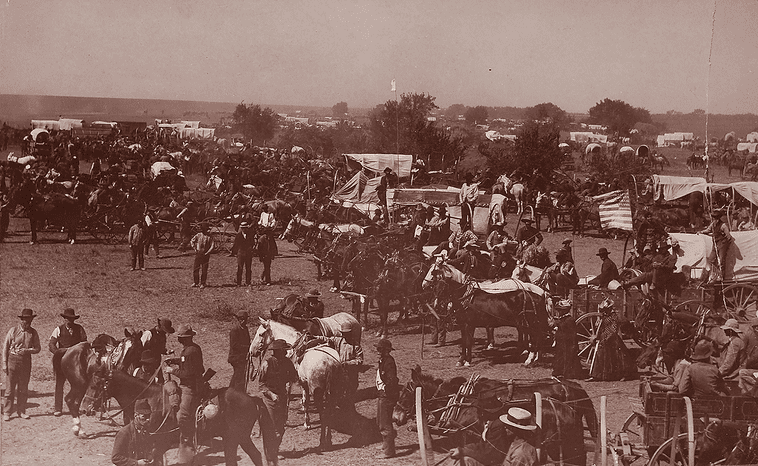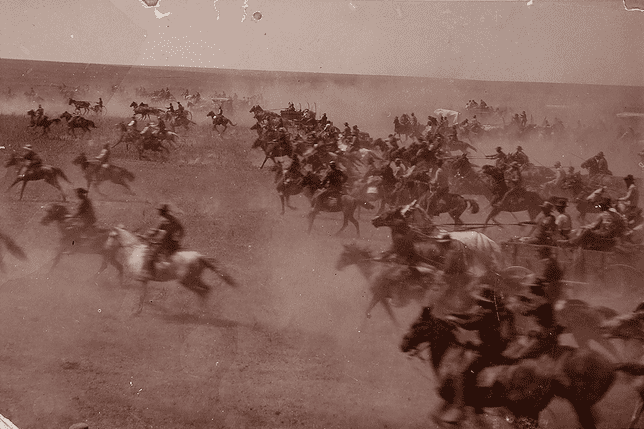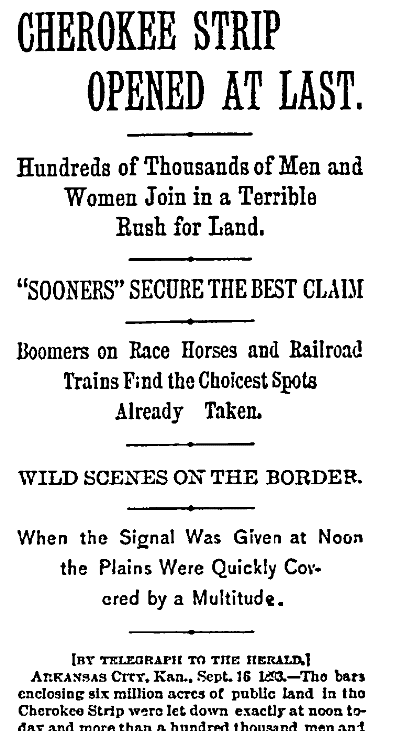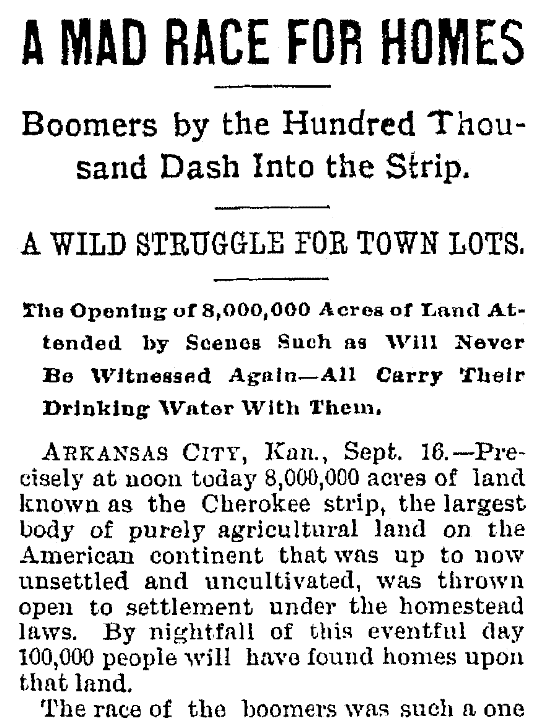Signaled by the boom of a cannon and the sharp report of carbines at exactly noon on 16 September 1893, the “Cherokee Strip” land run began in Oklahoma, one of the wildest, most frenetic spectacles in American history. Over 100,000 impoverished, desperate men and women had been barely surviving in dirty “boomer” camps in southern Kansas for months, awaiting the magical moment when the government would throw open six and a half million acres of public land to anyone who wanted to dash in and claim it.

When the noon signal was given the army and cavalry stepped back and let the mad scramble begin, and bedlam broke out.
A train that could carry 2,000 claimants into the interior was rushed by 15,000 determined people. In the chaos women had their clothes torn, men were trampled underfoot, and would-be passengers swarmed all over the train, even clinging to the roofs of the cars. Not patient enough to cross over a crowded ford, men whipped their frightened horses to jump over an 18-foot cliff into the creek waters below. The dust was so thick that a heavy wagon packed with supplies and six passengers drove right over the cliff and plunged into the creek.
People and animals were getting hurt, some even killed, and everywhere there was the roar of pounding hoofs, rushing wagon wheels, and yelling and screaming. The largest land run in the history of the world was underway.

Oklahoma actually had five land runs, each occurring as more and more Indian land was turned over to white settlers, and three (in 1889, 1891 and 1892) preceded the Cherokee Strip run. However, all paled in comparison to the vast amount of land opened up in that 1893 run. The U.S. economy was devastated by the Panic of 1893, an economic depression worse than anything the country had known.
People were out of work, bankrupt, starving, and crazed for any economic opportunity – and 6.5 million acres of land presented quite an opportunity. The chaos, urgency and desperation of the Cherokee Strip land run reflected the country’s dire times.
These two newspaper articles describe this incredible and little-known episode in America’s history. The first article gives an account of the actual start of the land run, and the second describes how the land run was supposed to operate.

Here is a transcription of this article:
CHEROKEE STRIP OPENED AT LAST.
Hundreds of Thousands of Men and Women Join in a Terrible Rush for Land.
“SOONERS” SECURE THE BEST CLAIM.
Boomers on Race Horses and Railroad Trains Find the Choicest Spots Already Taken.
WILD SCENES ON THE BORDER.
When the Signal Was Given at Noon the Plains Were Quickly Covered by a Multitude.
[BY TELEGRAPH TO THE HERALD.]
ARKANSAS CITY, Kan., Sept. 16, 1893. – The bars enclosing six million acres of public land in the Cherokee Strip were let down exactly at noon today and more than a hundred thousand men and women joined in the mad rush for land.
Men who had the fastest horses rode like the wind from the border only to find other men with sorry looking animals ahead of them. Fast teams carrying anxious home seekers were driven at breakneck speed only to find men on the land who had gone in afoot.
Every precaution had been taken to keep out the “boomer” element, and yet that same element, profiting by former experiences, had captured the land.
The rumble of teams could be heard all night as they moved out to the Strip. At the railroad stations the men stood in line at the ticket offices awaiting the slow movements of ticket sellers, who could not sell more than two thousand tickets an hour.
The great jam, however, was at Orlando, where were gathered twenty thousand Perry citizens, all anxious for the time to come when they could start on their ten mile race. The start was made at noon. For an hour before the borders of the Strip were black with men, horses and teams.
From the elevation at Orlando the line could be seen for a distance of eight miles east and ten miles west. In each direction the line was crowded until it appeared to be only a black ribbon outlined on the gray surface about them. Half a dozen times someone would shout the hour of noon and fifty to a hundred horsemen would draw out of the line, only to be driven back by the cavalrymen who were patrolling the Strip in front of the impatient throng.
WHEN THE SIGNAL WAS HEARD.
A puff of smoke was seen at last out on the plains to the north, and soon the dull report of a cannon was heard. A dozen carbines along the line were fired in response to the signal, and the line was broken.
Darting out at breakneck speed the racers soon dotted the plains in every direction. Following them came light vehicles driven with a madness that disregarded every obstruction, the drivers yelling and urging their horses with whip as well as voice. Then followed heavy wagons, enveloped in clouds of dust, the noise made by their wheels resembling long continued rolls of thunder. Behind these came anxious footmen carrying blankets, water and stakes, regardless of the heat and dust. Before them was the unknown, behind them were all the discomforts of Orlando.
The trains were loaded rapidly There was an attempt at first to examine the registration certificates, but this was soon given up, as the rushing thousands pushed those ahead of them, the trainmen giving all their time to collecting the tickets.
TRAINS LOADED TO THE ROOFS.
The first train of twelve cars pulled across the line at noon, crowded as trains never were before. Platforms and roofs of cars were as black with human life as were the interiors. Following this train, with an interval of only two or three minutes, went another and another until the last, consisting of flat and coal cars, all crowded, had pulled across the line, followed by at least 3,000 disappointed and panting men who were determined not to be deprived of their rights.
The run to Perry was made in three-quarters of an hour. Before the train stopped men began climbing out of the windows and jumping from the platform.
SCENES NEAR ARKANSAS CITY.
The south line of Cowley county, with Arkansas City as the centre, presented a scene almost as animated and exciting as that at Orlando. The hundred foot strip for a distance of more than twenty miles was filled with struggling, expectant humanity last night. Additions were made to the crowd all night long, and at ten o’clock this morning, east and west of the Chilocco school, there was a long black line. Men would start out occasionally, but threats, not to be disregarded, soon brought them back.
When the signal was given away they all went, and the scenes on the south line were repeated. There was a jam at Chilocco Creek, which, owing to the steep north bank, was passable at only a few points. In many instances men leaped their horses down the eighteen foot embankment, landing in the water and hastily scrambling out again. Others were so unfortunate as to cripple their horses and, abandoning them, started on foot.
Just east of the school a heavy wagon loaded with six men was driven over the bank, which was concealed by the clouds of dust that came up from the burned prairie. As the horses went over the men jumped and all escaped unhurt except one, who had his leg broken.
DEFYING THE SOLDIERS.
The trains for the south last night carried two thousand persons, ostensibly to Orlando. All the way down, however, the boomers kept dropping off the trains as they moved and when they stopped at stations. At Ponca, which is in the reservation, but two miles from the line, fully five hundred men left the train, defying the feeble efforts of the two soldiers who had been placed there to see that no one left the train.
These men did not become “sooners” until they crossed the line, and though their entrance from the reservation had been forbidden by the Secretary of the Interior they went out on the public domain from that point today, every one of them carrying a certificate of registration as credentials. Some of these men were town site speculators, while others were intending farmers.
All the towns in Oklahoma and Southern Kansas are practically deserted today.
NO ONE SLEPT IN GUTHRIE.
Few of the 150,000 boomers upon the border of the promised land at Guthrie, Oklahoma, closed their eyes in sleep last night. With prairie fires raging in front of them and with mind and body strained by the pent up excitement of the impending struggle, there was no room for sleep and no inclination to rest.
Wagons and boomers kept pulling up from the streams to which they had retired for water and pasturage and loaded railway trains continued to arrive, and before the break of day everybody was astir.
Thousands of letters were written home during the night and at morning’s dawn couriers were sent to the nearest post office loaded down with missives, for many and many a man, realizing the danger that was impending, felt that perhaps this might be his last race and sent his loved ones a farewell message or expressed his last wishes should the worst come.
There was a careful packing of all loose articles, a looking over of harness and saddle or oiling of wheels and a careful grooming of horses.
Thirty thousand certificates were issued at the Orlando booth, 33,000 at Hennessy and 20,000 at Stillwater. Everybody was registered, but it was necessary for the government to employ fifty clerks at some points instead of the three they started with.
Guthrie is deserted, all the banks and stores are closed and it is quieter than on Sunday. Every other city near the strip is in the same condition. All the men and half the women have gone to take part in the race.
SOLDIERS CLEAR A TRAIN.
More than fifteen thousand persons wanted to go in on the first train from Orlando, which had a capacity for fewer than two thousand. With a wild shout the crowd rushed forward. The soldiers on the ground were swept from their feet, and for a moment it seemed as if the mob would capture the train, for men and women were around and over the engine and tender, upon and under the platforms, and even upon the roofs of the coaches.
The blue-coated guardians soon recovered, however, and with fixed bayonets cleared the train and compelled everybody to show certificates before entering.
On every side men and women fought and struggled to get near the cars. Women had their clothes torn off and men were knocked down and trampled upon. Scores of persons were injured, yet the struggle kept up until the train was filled and it was repeated on a smaller scale with each succeeding train.

Here is a transcription of this article:
A MAD RACE FOR HOMES
Boomers by the Hundred Thousand Dash into the Strip.
A WILD STRUGGLE FOR TOWN LOTS.
The Opening of 8,000,000 Acres of Land Attended by Scenes Such as Will Never Be Witnessed Again – All Carry Their Drinking Water with Them.
ARKANSAS CITY, Kan., Sept. 16. – Precisely at noon today 8,000,000 [correction: 6.5 million – ed.] acres of land known as the Cherokee strip, the largest body of purely agricultural land on the American continent that was up to now unsettled and uncultivated, was thrown open to settlement under the homestead laws. By nightfall of this eventful day 100,000 people will have found homes upon that land.
The race of the boomers was such a one as will never be witnessed again probably, and the results in the record of expected bloodshed are soon to come.
A conservative estimate of the number of people who will be within the border of the Cherokee strip tonight is 300,000.
Racing for Town Lots.
Most of those in the race are making the run for town lots, and the great objective point is the government county seat and land office of Terry, 10 miles north of the Oklahoma line. The town site covers an area of 320 acres, which has been cut into nine lots to the acre, making 2,880 lots to be divided among the 20,000 people who will crowd in there as soon as possible. The Atchison, Topeka and Santa Fe railroad ran three trains of 10 coaches each south from this point and two trains of 10 coaches each north from Orlando.
Homeseekers at the last moment awakened to a realization of the necessity for carrying a supply of water with them into the new country, and all sorts of vessels were in demand for carrying it. The stock of canteens was soon exhausted, and tinners were busy soldering tops on ordinary tin wash basins, which were sold readily at $1 each. A large number of water wagons were rigged up, and they will move into the strip as rapidly as possible to supply water to claim makers. They expect to dispose of it at $1 a bucket tonight.
Registration was done at high pressure speed at the last. Booths were opened Friday morning in a large storeroom, and almost before the people generally knew what was going on a force of 20 clerks was at work taking the names and issuing certificates of registration to homeseekers.
They started out at the rate of 20 a minute. The opening of the booths here attracted many women and old men who had determined not to register at all rather than undergo the hardships at the border line. Many of those at the border who were near the foot of the long lines abandoned their places and came into the city to register.
Rules for Homeseekers.
The regulations under which the strip was opened to homeseekers were as follows:
Any person (man or woman), the head of a family or 21 years old, can enter a homestead of 160 acres upon the strip, provided they have not already enjoyed the benefits of the homestead act and are either citizens of the United States or have filed their declaratory statements. If you have made a homestead entry previous to March 2, 1889, and failed to perfect title to same up to this time, or have obtained land under the straight pre-emption or timber culture act, you are still eligible to take a homestead in the strip, provided you do not own 160 acres of land, for any person owning this amount of land in any state or territory is barred out from entering any land in Oklahoma.
Ex-soldiers or sailors or their widows or minor children can enter 160 acres by filing a declaratory statement, either in person or through an agent, and have six months in which to make entry and commence settlement.
Any person can initiate his homestead either by going upon the land first and filing afterward, or by going to the land office first, but the former way is the safest and best, as the first in point of time holds the land, and when you go to the land office and file upon a piece of land without having been upon it some other person may have settled upon it before the hour of your filing, and they would consequently get the land.
Only a few can get a chance to successfully file before all the land is settled upon on the day of the opening, so the surest and best way is to go upon the land first and make settlement, then go and file.
A Five Years’ Residence.
Every settler in the strip must live upon his land five years before he can obtain a title, and must also pay $2.50 per acre for land east of 97½ degrees west longitude, $1.50 per acre for land lying between 97½ and 98½ degrees west longitude and $1 per acre for all land west of 98½ degrees, and shall also pay interest upon the amount so to be paid for said land from the date of entry to the date of final payment therefore at the rate of 4 per cent per annum.
The special orders and regulations prescribed for this opening require that all persons intending to enter the land shall appear at registering booths established along the line, make affidavit as to their eligibility to take land and receive a certificate stating same. This certificate will serve as a pass and must also be presented at the land office when the person appears to file.
After a man has provided himself with a certificate at the booth he is all ready to enter the race for a farm. When the time arrives, he rides in until he finds a desirable piece of land unoccupied.
Note: An online collection of newspapers, such as GenealogyBank’s Historical Newspaper Archives, is not only a great way to learn about the lives of your ancestors – the old newspaper articles also help you understand American history and the times your ancestors lived in, and the news they talked about and read in their local papers. Did any of your ancestors participate in the Oklahoma Land Rush? Please share your stories with us in the comments section.
Related Article:
